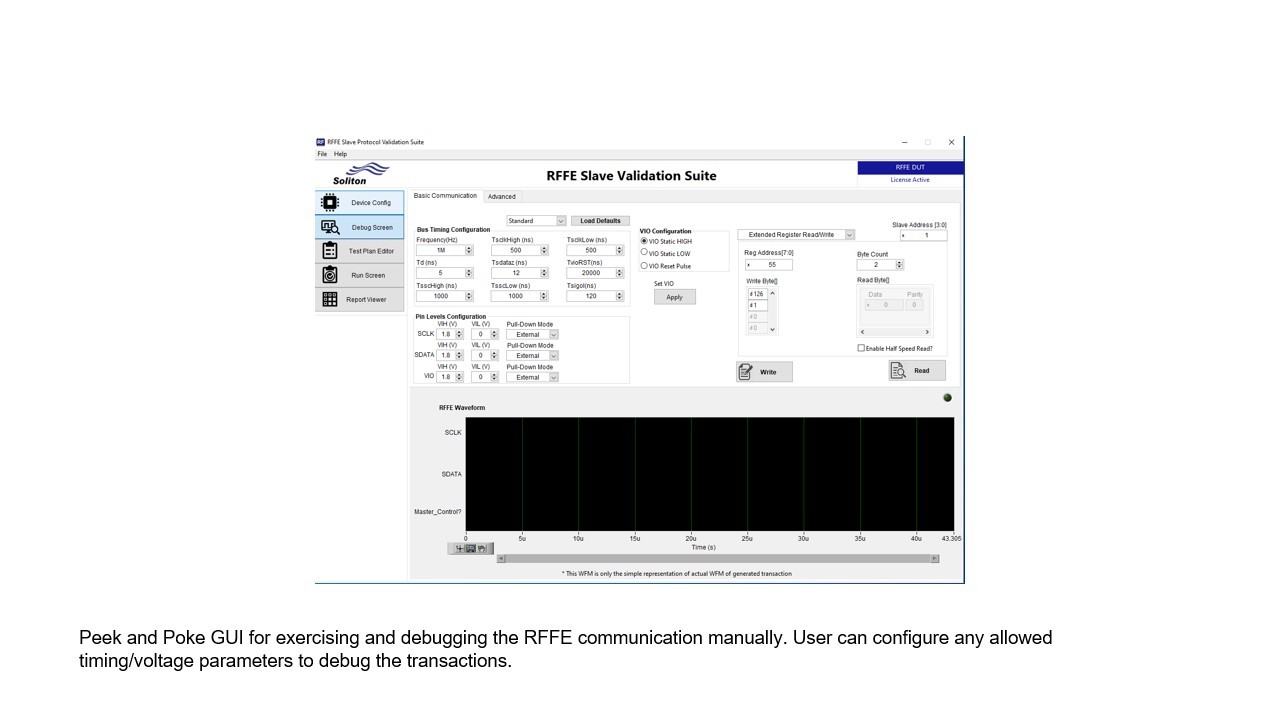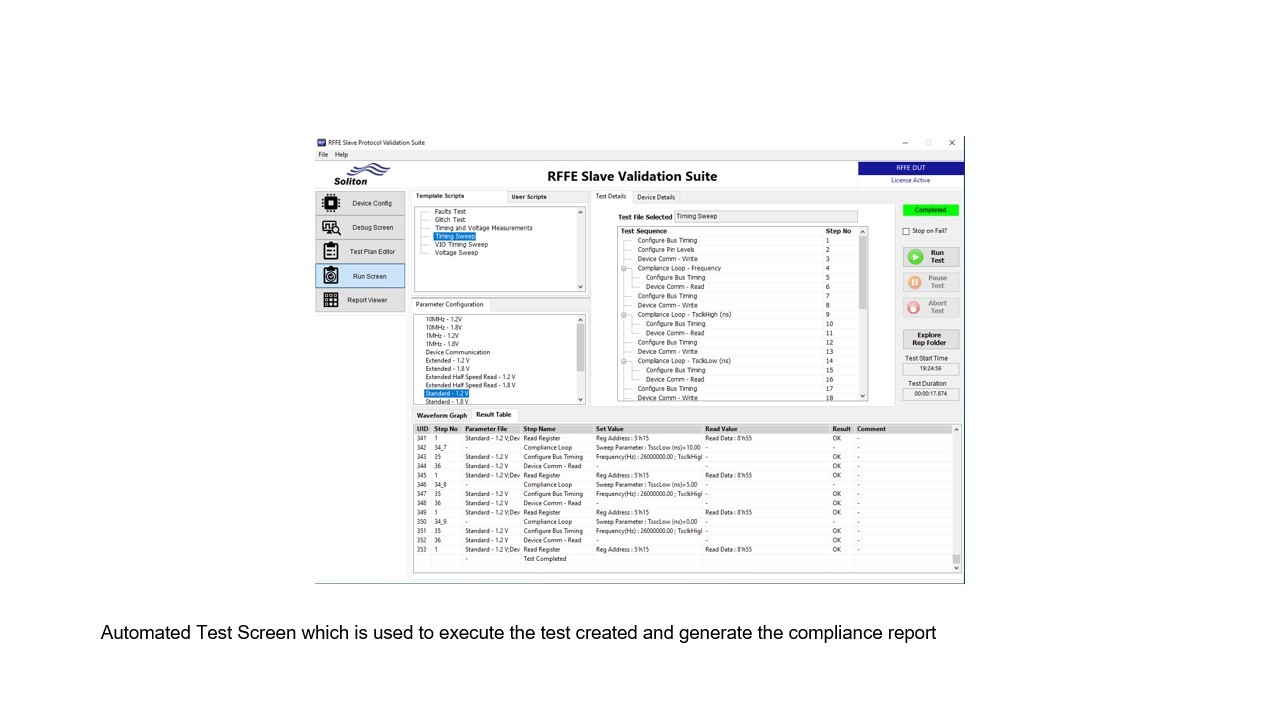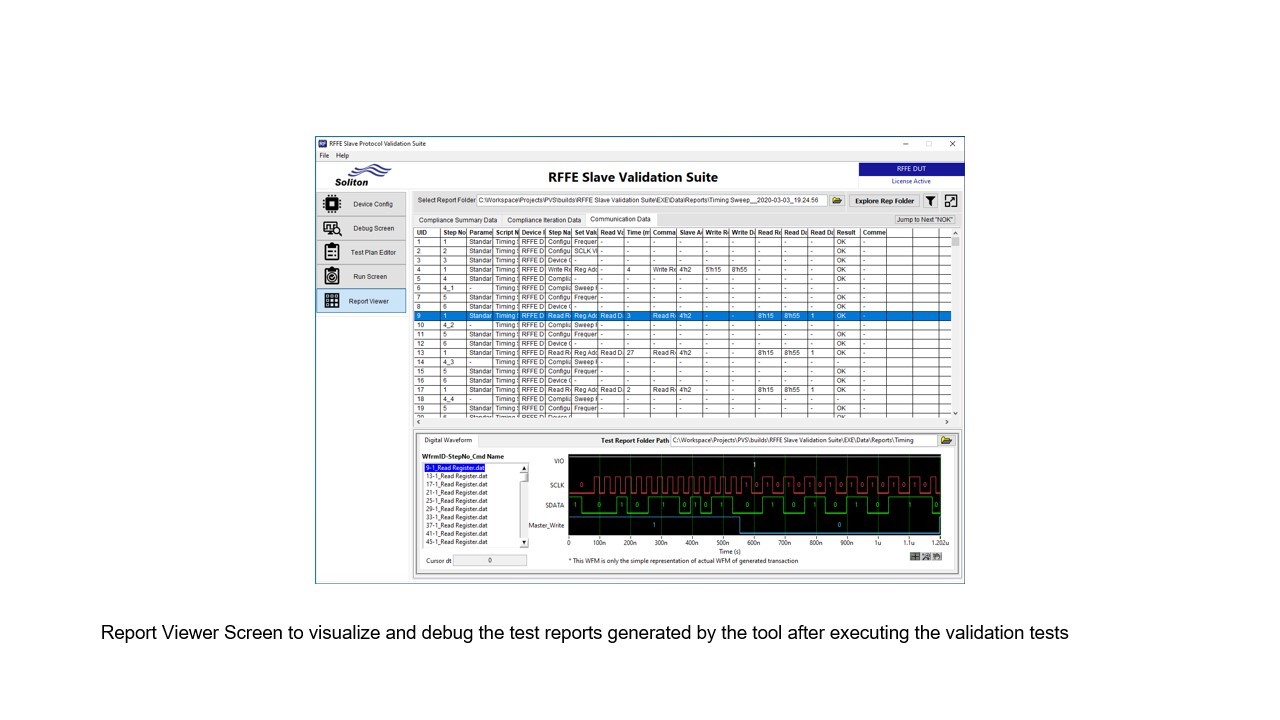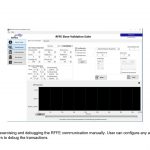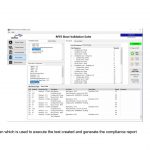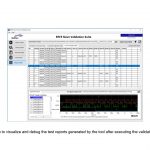DATA SHEET
 Download Datasheet - RFFE Protocol Validation Suite Specifications
Download Datasheet - RFFE Protocol Validation Suite Specifications
Download Datasheet - RFFE Protocol Validation Suite Specifications
Please enter your details, you will receive an immediate automated email with our RFFE Protocol Validation Suite Datasheet.
Product Details
- Overview
- Functional Coverage
- Parametric Coverage
- Features
- FAQ
Overview
The MIPI RF Front End Control Interface, MIPI RFFE, is the world’s de-facto standard interface for control of radio frequency (RF) front-end (FE) subsystems. It delivers fast, agile, semi-automated, and comprehensive control of the complex RF subsystem environment, which has rigorous performance requirements and can include up to 19 components per bus instance (up to 15 target devices and up to four master devices), including power amplifiers, LNAs, antenna tuners, filters, and switches.
As a part of product validation, it’s important to validate the product’s conformance against the protocol specification to ensure the interoperability of the product. As the complexity of the protocol and product increases, the validation time of the protocol interfaces also increases which in turn reduces the RTM. Performing the protocol conformance testing in the traditional way needs a lot of time and effort.
Soliton’s RFFE Validation Suite is an off the shelf validation tool using NI’s PXI Platform, which helps to validate the devices’ compliance with timing and electrical specifications of the MIPI RFFE protocol. The tool can also validate the devices tolerance to and recovery from a variety of RFFE faults & exceptions and provides a comprehensive set of reports. Users have claimed that, using this automated solution for RFFE Validation has brought down the test time/ validation time from a few weeks to a couple of days.
Functional Coverage
Frequency Ranges
- Standard Frequency Range (26MHz)
- Extended Frequency Range (52MHz)
FUNCTIONAL TESTS
- Register 0 Write
- Register Write
- Register Read
- Extended Register Write
- Extended Register Read
- Extended Register Write Long
- Extended Register Read Long
- Communication using GSID
FAULT TESTS
- Skip SSC (Sequence Start Condition)
- Skip a bit in Command/Address/Data Frame
- Send Invalid Command/Address/Data Frame
- Send additional bit in Command/Address/Data Frame
- Skip Parity Bit in Command/Address/Data Frame
- Induce Parity Error in Command/Address/Data Frame
- Send an incomplete Command/Address/Data Fram
- Send an incomplete command sequence
- Induce Bus Timeout with SDATA & SCLK pulled LOW
- Induce IO contention fault.
Parametric Coverage
Timing Parameters
- FSCLK SCL Clock Frequency
- TSCLKIH SCLK High Period
- TSCLKIL SCLK Low Period
- TSDATAZ SDATA Drive Release Time
- TSU SDATA Setup Time
- TH SDATA Hold Time
- TSSCHigh SSC High Time
- TSSCLow SSC Low Time
- TSCLKITR_Rise SCLK Rise Time
- TSCLKITR_Fall SCLK Fall Time
- TSDATAOTR_Rise SDATA Rise Time
- TSDATAOTR_Fall SDATA Fall Time
- TPD* Target SDATA Valid Time
- Tglitch Pulse width of glitch to filter
- TVIO-RST VIO Supply Reset Timing
- TSIGOL Input Signal Reset Delay Time
Electrical IO Parameters
- VTP Positive Going Input Threshold Voltage
- VTN Negative Going Input Threshold Voltage
- VH Schmitt Trigger Inputs Hysteresis
- VOL* Output Low Level
- VOH * Output High Level
- VVIO-RST VIO Supply Reset Voltage Level
Features
Features of RFFE Protocol Validation
- ISO 9001 Certified Product
- Simple, Flexible, Modular, and Light Bench Setup
- Easy to use RFFE Protocol Exerciser and Debugger to perform various RFFE transactions with controllable timings/voltage levels
- Protocol compliance testing with zero coding
- Comprehensive reporting feature to report the test pass/fail reports
- Generates Full Compliance reports in less than 2 hours
- Reproduce failure cases in a few clicks
- Easy to build and test custom device-specific tests
- Automation Capability (DLLs/APIs) from external programming environment/automation frameworks like LabVIEW, C#, Python, TestStand, etc
- Leverage Soliton’s experience in protocol validation and debugging
FAQ
What kind of engagement models are offered for RFFE Validation?
We offer 2 engagement models. In the First mode, the user can purchase a license of the RFFE Validation Suite and do the validation inhouse. In the second mode, the user can send us 3 DUT's, we will do the validation and send the test reports in 3 working days.
How is this product different from existing Protocol Exercisers, Debugger or Analyzers?
This product is mainly used for performing functional and electrical compliance validation of the RFFE devices (post-silicon validation) whereas the other existing protocol exercisers, debuggers, or analyzers are used for performing basic functional tests during the device bring up
Can't I build a home-grown solution instead?
While this is certainly an option, we expect that it will take a highly experienced automation engineer between 3-6 months to create a first version of a similar tool. To create a robust and flexible tool takes experience, and we have been improving this tool over the last 3 years since its release. We believe it is worth the cost to skip the learning curve and avail of our comprehensive report or validation suite.
What else can I do with NI's PXI chassis/modules?
The PXIe-657x module is a general-purpose programmable pattern generator and acquisition device with deep memory. It can be used for other protocol validation tools from us. Also, it can be programmed using LabVIEW or other programming languages to emulate any synchronous digital protocol. NI’s PXI chassis supports high bandwidth and synchronization-friendly control and reads back from a huge variety of digital, analog, and special-purpose modules in a compact form factor.
What is the interposer board referenced in the system diagram?
The Protocol Validation Suite requires custom external circuitry for signal conditioning. Each purchase comes with a complimentary interposer board, which is a separate PCB designed and delivered by us.
Which oscilloscope models are supported?
The Protocol Validation Suite supports any NI scope by default. The tool has a flexible architecture that allows the support of other oscilloscope models. We can help you in building the oscilloscope plugin for one of your oscilloscopes
What type of documentation and training will be available for each solution?
User manuals, Getting started guides, and tutorial videos are available for each solution and can be easily accessed from within the product. Additionally, we will provide short live training sessions upon request.
Can the tool be used for out-of-the-box validation?
Yes, The tool comes without of box test scripts which can be used for validation after entering the device-specific details
Why was RFFE Master- RFFE Slave terms are renamed to RFFE Controller RFFE-Target?
As a part of terminology replacement efforts, we have deprecated the Master-Slave terminologies and replaced them with Controller-Target terminologies in our documents. When the MIPI Organization finalizes a different terminology, we will be updated new terminology
Technical Documentation
Soliton’s RFFE Validation Suite is an off the shelf validation tool using NI’s PXI platform, which helps to validate the devices’ compliance with the timing and electrical specifications of the MIPI RFFE protocol. It contains the below components.
- NI PXIe 657x – Digital Pattern Generation Card with the PXIe Chassis setup
- Soliton PVS Interposer Board
- Oscilloscope – For performing voltage measurements
- Soliton RFFE Validation Suite Software compatible with Windows OS (Win 10)
For more details, download the datasheet
 Download Datasheet - RFFE Protocol Validation Suite Specifications
Download Datasheet - RFFE Protocol Validation Suite Specifications
Download Datasheet - RFFE Protocol Validation Suite Specifications
Please enter your details, you will receive an immediate automated email with our RFFE Protocol Validation Suite Datasheet.
Hardware
Soliton’s RFFE Validation suite is based on the NI – PXI Platform and the NI part configuration lists the hardware required to perform the validation
The solution also needs a custom Interposer Board for signal conditioning purposes.
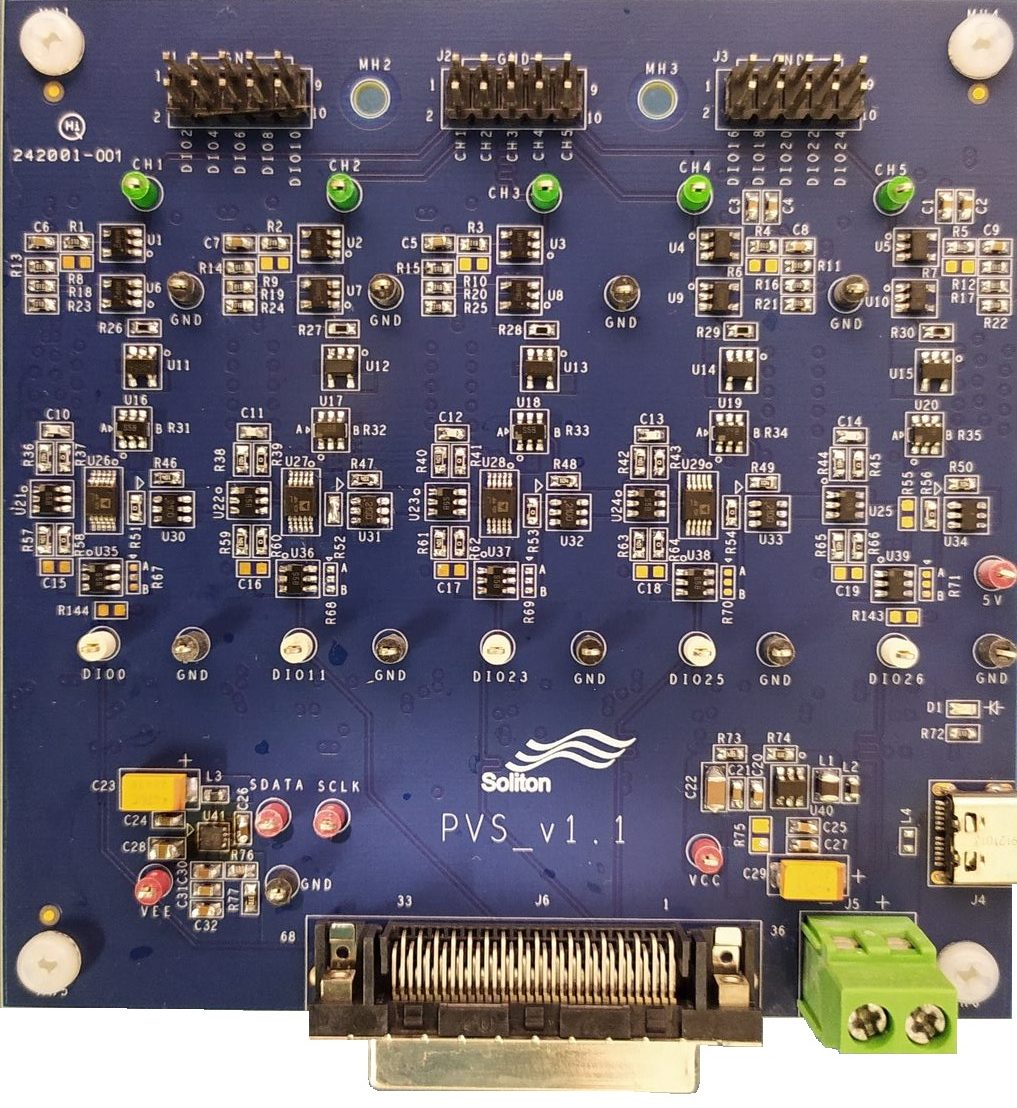
Support & Training
For any queries, contact us at [email protected]. We will respond within 1 Business day.
TYPICAL USER BASE FOR RFFE VALIDATION SUITE
- Design Engineers, Test Engineers, Post Silicon Validation Engineers, Engineering Managers, Validation Managers, Lab Managers, etc from the Semiconductor Industry.
- Post Silicon validation of Chips with RF Front End Interface (RFFE)
- Semiconductor Chip Manufacturers making RFFE Devices
OTHER PROTOCOL VALIDATION SERVICES OFFERED BY SOLITON
I2C Protocol Validation ![]() I3C Protocol Validation
I3C Protocol Validation ![]() SPI Protocol Validation
SPI Protocol Validation ![]() SPMI Protocol Validation
SPMI Protocol Validation ![]()
UART Protocol Validation ![]() SMBus Protocol Validation
SMBus Protocol Validation ![]() PMBus Protocol Validation
PMBus Protocol Validation ![]()
Demo Request Form
Please fill in the following form and we shall get in touch with you soon to set up a demo of the requested service/product. Thank you!
Error: Contact form not found.
DOWNLOAD NOW
Fill in this form and submit for your download to start automatically
Error: Contact form not found.
Download PRIM Brochure
Submit this form and the PRIM Brochure document will be sent to your email.
Error: Contact form not found.
